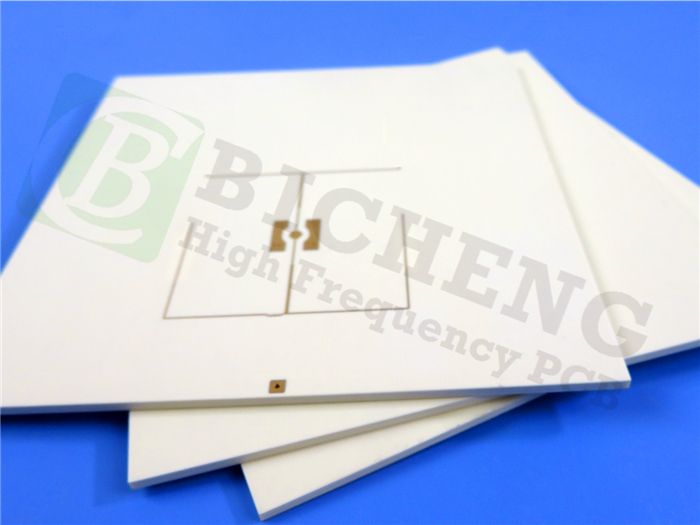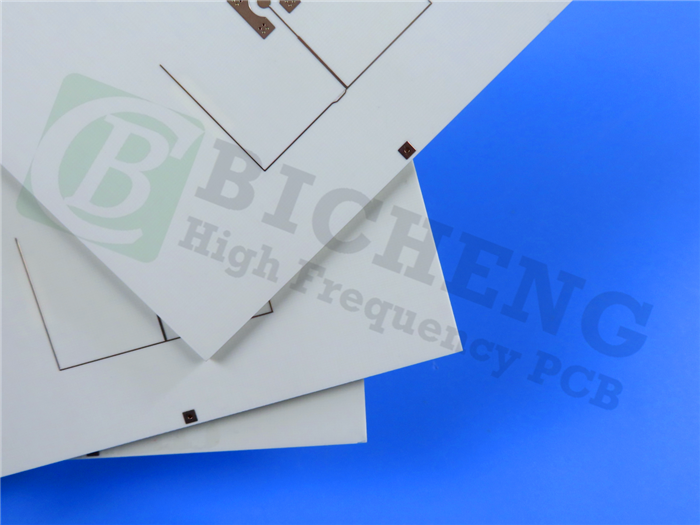Kappa 438 RF PCB – Rogers 60mil 1.524mm DK 4.38 with Immersion Gold for Wireless Meters
(Printed Circuit Boards are custom-made products, the picture and parameters shown are just for reference)
Revolutionize Your RF PCB Designs with Rogers Kappa 438 Laminates
Take your RF PCB designs to the next level with Rogers Kappa 438 laminates, engineered for exceptional high-frequency performance and cost-effective fabrication. Designed with a glass-reinforced hydrocarbon ceramic system, these laminates deliver low-loss properties and are fully compatible with standard FR-4 processing techniques. Kappa 438 laminates meet the UL 94 V-0 flame retardant rating and are optimized for lead-free soldering processes, making them ideal for advanced applications like wireless meters and IoT devices.
With a dielectric constant (Dk) of 4.38, Kappa 438 laminates align seamlessly with FR-4 industry standards, enabling easy upgrades to existing designs for enhanced electrical performance and reliability.
Key Features of Kappa 438 Laminates
1.Advanced Material Composition: Built on a glass-reinforced hydrocarbon thermoset platform, ensuring durability and performance.
2.Optimized Dielectric Constant (Dk): A Dk of 4.38 ensures consistent signal integrity and minimal signal loss in high-frequency applications.
3.Precision Tolerances: Tighter Dk and thickness tolerances compared to traditional FR-4 materials.
4.Low Z-Axis CTE: A low coefficient of thermal expansion (42 ppm/°C) ensures stability under thermal stress.
5.High Glass Transition Temperature (Tg): With a Tg of >280°C (TMA), Kappa 438 excels in high-temperature environments.
6.Flame Retardant: Meets UL 94-V0 requirements, ensuring safety and compliance.

Why Choose Kappa 438 Laminates?
Ease of Manufacturing: Simplifies PCB production and assembly, fully compatible with standard FR-4 processes.
Design Flexibility: The tailored Dk allows for easy conversion of existing FR-4 designs, enabling enhanced electrical performance without major redesigns.
Consistent Performance: Ensures reliable and consistent circuit performance across a wide range of applications.
Enhanced Reliability: Improves design flexibility and plated through-hole reliability, ensuring long-term durability.
Automation-Friendly: Ideal for automated assembly processes, reducing production time and costs.
Applications of Kappa 438 Laminates
Kappa 438 laminates are perfect for a wide range of high-frequency applications, including:
1.Carrier-Grade WiFi / Licensed Assisted Access (LAA)
2.Small Cell and Distributed Antenna Systems (DAS)
3.Vehicle-to-Vehicle / Vehicle-to-Infrastructure Communications (V2X)
4.Internet of Things (IoT) Devices
5.Segments: Smart Home and Wireless Meters


Our PCB Capability (Kappa 438)
PCB Capability (Kappa 438) |
|
PCB Material: |
Glass Reinforced Hydrocarbon Ceramic |
Designation: |
Kappa 438 |
Dielectric constant: |
4.38 at 2.5GHz |
Layer count: |
Single Layer, Double Layer, Multilayer, Hybrid PCB |
Copper weight: |
1oz (35 µm), 2oz (70µm) |
PCB thickness: |
10mil (0.254mm), 20mil (0.508mm), 30mil (0.762mm), 40mil (1.016mm), 60mil (1.524mm) |
PCB size: |
≤400mm X 500mm |
Solder mask: |
Green, Black, Blue, Yellow, Red etc. |
Surface finish: |
Bare copper, HASL, ENIG, Immersoin silver, Immersion tin, OSP, ENEPIG, Pure gold etc.. |
Upgrade Your RF PCB Designs with Kappa 438 Laminates!
Whether you're working on wireless meters, IoT devices, or V2X communications, Rogers Kappa 438 laminates offer the perfect combination of performance, reliability, and cost efficiency. With low-loss properties, high-temperature stability, and ease of manufacturing, Kappa 438 is the ideal choice for your next high-frequency PCB project.

Data Sheet of Kappa 438 Laminate
Property |
Typical Value Kappa 438 |
Direction |
Units |
Condition |
Test Method |
Dielectric Constant, er Design |
4.38 |
Z |
- |
2.5 GHz |
Differential Phase Length Method |
Dissipation Factor tan, d |
0.005 |
Z |
- |
10 GHz/23°C |
IPC-TM-650 2.5.5.5 |
Thermal Coefficient of Dielectric Constant e |
-21 |
- |
ppm/°C |
10 GHz (-50 to 150°C) |
Modified IPC-TM-650 2.5.5.5 |
Volume Resistivity |
2.9 x 109 |
- |
MΩ•cm |
COND A |
IPC-TM-650 2.5.17.1 |
Surface Resistivity |
6.2 x 109 |
- |
MΩ |
COND A |
IPC-TM-650 2.5.17.1 |
Electrical Strength |
675 |
Z |
V/mil |
- |
IPC-TM-650 2.5.6.2 |
Tensile Strength |
16 12 |
MD CMD |
kpsi |
- |
ASTM D3039/D3039-14 |
Flexural Strength |
25 19 |
MD CMD |
kpsi |
- |
IPC-TM-650 2.4.4 |
Dimensional Stability |
-0.48-0.59 |
MD CMD |
mm/m |
- |
IPC-TM-650 2.4.39a |
Coefficient of Thermal Expansion |
13 |
X |
ppm/°C |
-55 to 288°C |
IPC-TM-650 2.4.41 |
16 |
Y |
||||
42 |
Z |
||||
Thermal Conductivity |
0.64 |
Z |
W/(m.K) |
80°C |
ASTM D5470 |
Time to Delamination (T288) |
>60 |
- |
minutes |
288°C |
IPC-TM-650 2.4.24.1 |
Tg |
>280 |
- |
°C TMA |
- |
IPC-TM-650 2.4.24.3 |
Td |
414 |
- |
°C |
- |
IPC-TM-650 2.3.40 |
Moisture Absorption |
0.07 |
- |
% |
24/23 |
IPC-TM-650 2.6.2.1 |
Young’s Modulus |
2264 2098 |
MD CMD |
kpsi |
- |
ASTM D3039/D3039-14 |
Flex Modulus |
2337 2123 |
MD CMD |
kpsi |
- |
IPC-TM-650 2.4.4 |
Bow |
0.03 |
- |
% |
- |
IPC-TM-650 2.4.22C |
Twist |
0.08 |
- |
% |
- |
IPC-TM-650 2.4.22C |
Copper Peel Strength After Thermal Stress |
5.8 |
- |
lbs/in |
1 oz (35 µm) foil |
IPC-TM-650 2.4.8 |
Flammability |
V-0 |
- |
- |
- |
UL 94 |
Specific Gravity |
1.99 |
- |
g/cm3 |
- |
ASTM D792 |
Lead-Free Process Compatible |
Yes |
- |
- |
- |
|